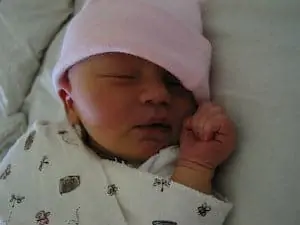Swaddling is one of the best tricks that a parent has to help their baby relax and sleep. Parents have to learn how long to swaddle a newborn during the day and at night for proper safety.
Babies need time to be without a swaddle during the night, and it’s necessary to watch out that you aren’t swaddling your baby for too long. Overswaddling a baby leads to risks, such as missing feeding cues and overheating.
If you’re wondering how long you should swaddle your baby, here is what you need to know. Make sure you follow the recommendations!
Should I Swaddle My Newborn at Night?
Yes, you should swaddle your newborn at night if your baby sleeps well, but make sure your baby continues to eat well at night. Newborn babies need to wake up and eat in the middle of the night to maintain weight, and if you’re breastfeeding, you need your baby to wake up to keep your milk supply as well.
If you find that the swaddle causes your newborn to sleep longer than four to five hours at a time, set the alarm to wake up and feed your baby. This is only for a short period, but babies need to eat and grow.
It’s safe to swaddle your baby all night long. Most babies prefer to be swaddled at night, and it helps them feel comfortable and sleep for longer stretches than two hours.
Should I Swaddle My Newborn All The Time?

In general, a newborn baby can safely be swaddled for 12-20 hours, depending on how long they’re awake. Newborns are usually awake no longer than 30-45 minutes at a time. Make sure you include nighttime sleeping in the total amount of time you swaddle your baby.
When your baby wakes up after nap time, take them out of the swaddle and change their diaper. This is the best time to leave your baby unswaddled; they don’t need to be swaddled when they’re awake unless you find that your baby is fussy.
Make sure you don’t feed your baby while they’re swaddled, especially if you’re breastfeeding. Babies need to have their hands and arms available when they’re eating.
Depending on what schedule you follow, your baby will either go to sleep after eating or after a short wakeful period. That’s when you should swaddle your baby again and lay him down for another nap. If you only swaddle your baby when he’s awake, feel confident that you aren’t swaddling your baby too much.
How Long Do Babies Like to Be Swaddled?
Babies love to be swaddled for several months, but when you notice that your baby fights the swaddle, it’s time to start transitioning from swaddling.
This happens at different ages but most often by four months old. You must start swaddling by the time that your baby rolls over from back to belly. Some babies start to roll over as early as eight weeks old, but nearly all babies roll by four months old.
As your baby gets older, you’ll swaddle them less because they’ll be awake for longer stretches. An average four-month-old stays awake anywhere from 1.5 to 2 hours between naps compared to 30-45 minutes during the newborn month. That’s a natural decrease in how long to swaddle your baby.
Can a Newborn Be Swaddled Too Much?
Yes, a newborn can be swaddled too much, mostly if the swaddling is done improperly. Here are some reasons why you can swaddle a baby too much.

Missing Feeding Cues
Swaddling naturally decreases a parent’s ability to notice their baby’s feeding cues. Some babies will sleep straight through their early feelings of hunger and wake up starving. Feeding a starving baby is miserable for everyone, especially if you breastfeed. Breastfeeding a starving baby makes it harder for them to latch.
Newborns need to eat often to meet their milestones. It’s safe to go two to three hours between feedings, but if you notice that your baby is regularly sleeping over these goals, then you might be swaddling too much.
Hip Dysplasia
Improper swaddling could cause hip dysplasia. When babies are in the womb, their legs naturally go into the fetal position, bent at the knees. Improper swaddling causes the sudden stretching of the legs, damaging joints, and the soft cartilage around the socket.
Parents must take responsibility to learn how to swaddle properly. Swaddling is safe when done correctly.
Overheating
Another risk of swaddling is overheating. This happens when you use the wrong fabric for swaddling based on your house’s temperature or season or when you add too many layers under a swaddle. Never put a cap on your baby’s head when swaddling.
Keep an eye on your baby when they’re swaddled. They won’t necessarily wake up when they’re too hot, so it’s your job to keep an eye on their safety. Overheating increases the risk of SIDS, so avoid this.
Less Wakeful Periods
As babies get older, they stay awake for longer stretches, but if you swaddle your baby as soon as they wake up or eat, they might dose back off again.
It goes without saying that:
There is an important balance that needs to be maintained for proper sleep. Babies need to have wakeful periods throughout the day to teach their bodies the difference between day and night time. It encourages their natural circadian rhythm for sleeping.
Make it a goal to leave your baby out of the swaddle until it’s time for a nap again. Learn how long a baby should be awake at each period and avoid overstimulation.
Final Thoughts
How long you should swaddle a newborn during the day and at night is a total of 12-20 hours. Make sure to give your baby adequate time without the swaddle after they wake up from each nap, and adjust that time as your child ages. Babies love swaddling but only for a short period.
Hey, this is Linda. My biggest accomplishment in life is being a mother of four children. Their current ages range from almost ten years old down to 20 months old.
I’m passionate about writing parenting articles because I understand so well all of the problems and trials you face as a parent. From breastfeeding woes to budgeting problems and behavior problems, along with everything in between, chances are I’ve faced it over the last ten years. Read more about Linda here.






